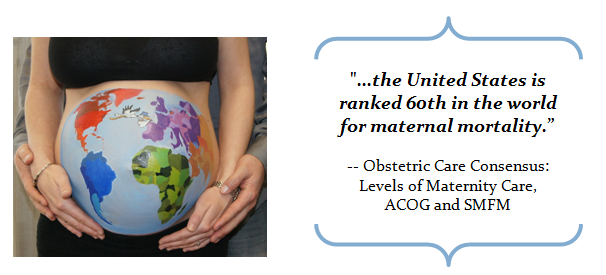In a joint statement released last month entitled Obstetric Care Consensus: Levels of Maternity Care the American Congress of Obstetricians and Gynecologists (ACOG) and the Society for Maternal-Fetal Medicine (SMFM) called for the creation and adoption of a classification system for maternity care. The statement outlines five levels of care which increase in their ability to handle medical complications for pregnant and postpartum women: Birth Centers, Level 1 (Basic Care), Level II (Specialty Care), Level III (Subspecialty Care) and Level IV (Regional Perinatal Health Care Centers).
The statement goes on to describe each level of care center, the type of care providers available and examples of the patients appropriate for each. For example, birth centers are described as providing care for low risk women, those with uncomplicated, singleton pregnancies with a baby in the vertex position. The capabilities of a birth center include the ability to provide low-risk maternal care, transfers to a higher level facility should the need arise and medical consultation at all times. In this document, every patient at a birth center is to be attended by certified nurse midwives, certified professional midwives and other legally licensed midwives. Level III facilities, on the other hand, care for complex maternal, obstetric and fetal conditions and provide advanced imaging services such as ultrasound at all times, have medical and surgical intensive care units for pregnant patients, offer round the clock anesthesia services onsite, and have both maternal fetal medicine specialists and critical care providers onsite at all times. The overall idea is to match the patient with the right level of care for her needs so as to improve outcomes for maternity care. ACOG and SMFM propose that this system be coordinated regionally so that patients have access to varying levels of care.
This idea of a tiered and integrated system of care based on specific capabilities is not at all new. In fact, in 1976, the March of Dimes issued a report (Toward Improving the Outcome of Pregnancy) that outlined a system to create designated levels of care for pregnant women and newborns based on their medical needs. In the nearly forty years since, a tiered system for neonatal care has been put in place based on the capabilities and staffing at hospitals and was last updated in 2012. Last month’s ACOG and SMFM statement notes that studies have shown that this system has improved outcomes for babies and calls for a similar system for maternity care. Currently, Arizona, Indiana and Maryland have guidelines which establish maternal care criteria but the three are operating independently and do not use the same designations or descriptions for each level. ACOG and SMFM suggest a nationally consistent system using agreed upon definitions and criteria.
At first glance, Obstetric Care Consensus: Levels of Maternity Care may appear to be of more interest to hospital administrators who want to obtain the appropriate designation for their facility than birthing families or the doulas who support them. However, this document has a great deal of educational value that doulas can reference. The descriptions for each facility level can help families better understand the differences between facilities and make more informed choices for a birthing location that best meets their medical needs as well as understand why they might be transferred to a higher level facility should complications arise. This joint statement also clearly supports midwifery care for uncomplicated pregnancies and birth centers as appropriate options for low risk mothers. This is very important in ensuring that families have a range of choices in care provider and facility for their births.
It is unclear how long it will take for such a system to be adopted nationwide. The report notes that many barriers will need to be overcome to implement such a system including determining if state or even national accreditation organizations need to be established and funded to oversee this system.
This is the second joint statement from ACOG and SMFM. Last year they jointly issue Safe Prevention of the Primary Cesarean Delivery, which directly referenced the value of doula support in lowering the cesarean birth rate. We can likely expect more collaboration between these two maternity care organizations in the future.


